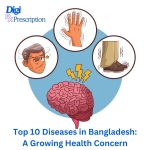Bangladesh, a densely populated country in South Asia, faces significant health challenges due to rapid urbanization, environmental pollution, and limited healthcare infrastructure. Both infectious and non-communicable diseases contribute to high morbidity and mortality rates, affecting millions every year. This article highlights the top 10 most prevalent diseases in Bangladesh, their causes, symptoms, and preventive measures.
1. Dengue Fever
Cause: Dengue virus transmitted by Aedes mosquitoes.
Symptoms:
✔️ High fever
✔️ Severe body pain (often called "breakbone fever")
✔️ Headache
✔️ Skin rash
✔️ Bleeding in severe cases
Prevention:
✔️ Eliminate mosquito breeding sites
✔️ Use mosquito nets and repellents
✔️ Wear protective clothing
Why It’s a Concern: Dengue outbreaks have become more frequent, especially during the monsoon season.
2. Diarrheal Diseases (Cholera, Dysentery, Rotavirus, etc.)
Cause: Contaminated food and water, poor sanitation.
Symptoms:
✔️ Frequent watery stool
✔️ Dehydration
✔️ Vomiting
✔️ Abdominal cramps
Prevention:
✔️ Drink clean and safe water
✔️ Practice handwashing and proper hygiene
✔️ Maintain food safety
Why It’s a Concern: Bangladesh has struggled with waterborne diseases for decades due to poor sanitation in many areas.
3. Respiratory Infections (Pneumonia, Tuberculosis, COVID-19)
Cause: Bacterial or viral infections, air pollution, smoking.
Symptoms:
✔️ Persistent cough
✔️ Fever and chills
✔️ Difficulty breathing
✔️ Chest pain
Prevention:
✔️ Get vaccinated (BCG for TB, Flu, and COVID-19 vaccines)
✔️ Avoid air pollution and smoking
✔️ Maintain good hygiene
Why It’s a Concern: Pneumonia and tuberculosis (TB) remain leading causes of death, while COVID-19 has added further strain to the healthcare system.
4. Cardiovascular Diseases (Heart Disease, Stroke, Hypertension)
Cause: Unhealthy diet, smoking, high cholesterol, obesity, stress.
Symptoms:
✔️ Chest pain
✔️ Shortness of breath
✔️ Dizziness
✔️ High blood pressure
Prevention:
✔️ Regular exercise
✔️ A heart-healthy diet
✔️ Quit smoking and reduce stress
Why It’s a Concern: Non-communicable diseases (NCDs) are rising rapidly in Bangladesh due to lifestyle changes and urbanization.
5. Malnutrition (Undernutrition and Obesity)
Cause: Poor diet, poverty, food insecurity, lack of awareness.
Symptoms:
✔️ Stunted growth (in children)
✔️ Weakness and fatigue
✔️ Frequent infections
✔️ Developmental delays
Prevention:
✔️ Eat a balanced diet rich in vitamins and minerals
✔️ Breastfeed infants for at least six months
✔️ Government-led nutrition programs
Why It’s a Concern: Bangladesh still struggles with both undernutrition in rural areas and obesity in urban populations.
6. Diabetes
Cause: Poor diet, lack of exercise, genetic factors.
Symptoms:
✔️ Frequent urination
✔️ Excessive thirst and hunger
✔️ Fatigue
✔️ Slow-healing wounds
Prevention:
✔️ Maintain a healthy weight
✔️ Control sugar intake
✔️ Regular health checkups
Why It’s a Concern: Type 2 diabetes cases are increasing due to unhealthy eating habits and sedentary lifestyles.
7. Typhoid Fever
Cause: Salmonella typhi bacteria from contaminated food and water.
Symptoms:
✔️ High fever
✔️ Weakness
✔️ Abdominal pain
✔️ Loss of appetite
Prevention:
✔️ Get vaccinated
✔️ Drink safe, boiled water
✔️ Follow proper food hygiene
Why It’s a Concern: Poor sanitation and unhygienic food handling make typhoid a persistent problem in Bangladesh.
8. Hepatitis (Hepatitis A, B, C, and E)
Cause: Viral infections from contaminated food, water, or blood transfusion.
Symptoms:
✔️ Jaundice (yellowing of skin and eyes)
✔️ Fatigue
✔️ Nausea and vomiting
✔️ Dark-colored urine
Prevention:
✔️ Get vaccinated (for Hepatitis A and B)
✔️ Avoid unsafe injections or unsterilized medical equipment
✔️ Maintain good hygiene
Why It’s a Concern: Hepatitis B and C are leading causes of liver disease and cancer in Bangladesh.
9. Kidney Disease
Cause: High blood pressure, diabetes, dehydration, infections.
Symptoms:
✔️ Swelling in legs and hands
✔️ Fatigue
✔️ Reduced urine output
✔️ High blood pressure
Prevention:
✔️ Stay hydrated
✔️ Control diabetes and hypertension
✔️ Avoid excessive use of painkillers
Why It’s a Concern: Chronic kidney disease (CKD) is increasing due to rising diabetes and hypertension rates.
10. Cancer (Lung, Liver, Cervical, Breast, etc.)
Cause: Smoking, pollution, infections (HPV, Hepatitis B), genetics.
Symptoms:
✔️ Unexplained weight loss
✔️ Persistent pain
✔️ Lumps or abnormal growths
✔️ Chronic cough or bleeding
Prevention:
✔️ Regular screenings and early detection
✔️ Avoid smoking and alcohol
✔️ Get vaccinated (HPV, Hepatitis B)
Why It’s a Concern: Cancer cases are rising due to environmental pollution, tobacco use, and late diagnoses.
Final Thoughts: A Call for Better Healthcare
The growing burden of diseases in Bangladesh highlights the urgent need for better healthcare facilities, preventive measures, and public awareness. Investing in sanitation, vaccination programs, and lifestyle changes can significantly reduce disease prevalence.
✅ What You Can Do:
✔️ Maintain a healthy lifestyle
✔️ Follow vaccination schedules
✔️ Prioritize hygiene and sanitation
✔️ Get regular health checkups
By taking proactive steps, we can build a healthier future for Bangladesh! ????????
What health concerns do you think should be addressed in Bangladesh? Share your thoughts in the comments! ????????
References:
- World Health Organization (WHO) Bangladesh – https://www.who.int/bangladesh
- Bangladesh Bureau of Statistics (BBS) Health Report – http://www.bbs.gov.bd
- International Centre for Diarrhoeal Disease Research, Bangladesh (icddr,b) – https://www.icddrb.org
- Centers for Disease Control and Prevention (CDC) – South Asia Health Risks – https://www.cdc.gov/globalhealth/countries/bangladesh
- Bangladesh Ministry of Health & Family Welfare – http://www.mohfw.gov.bd
- National Institute of Cardiovascular Diseases (NICVD) Bangladesh – https://www.nicvd.org
- UNICEF Bangladesh – Nutrition & Child Health – https://www.unicef.org/bangladesh
- National Cancer Research Institute Bangladesh – http://www.ncri.org.bd
These references provide up-to-date and reliable information on the health situation in Bangladesh. Always check official government and health organization websites for the latest data and research.

